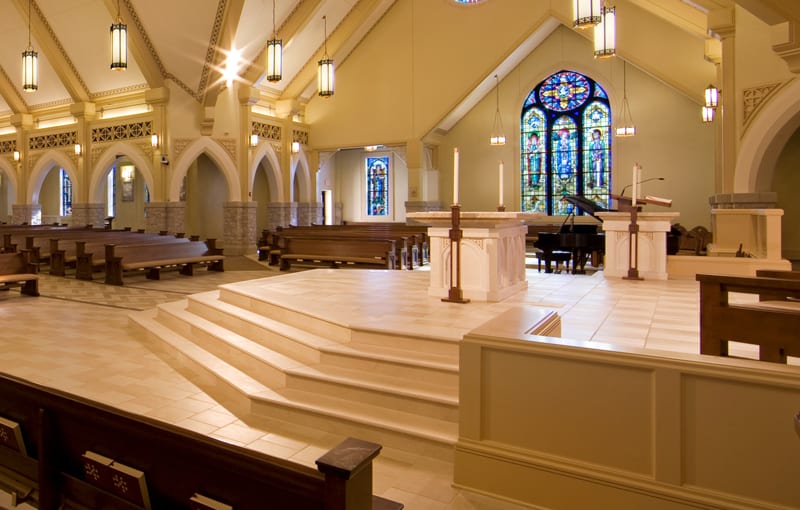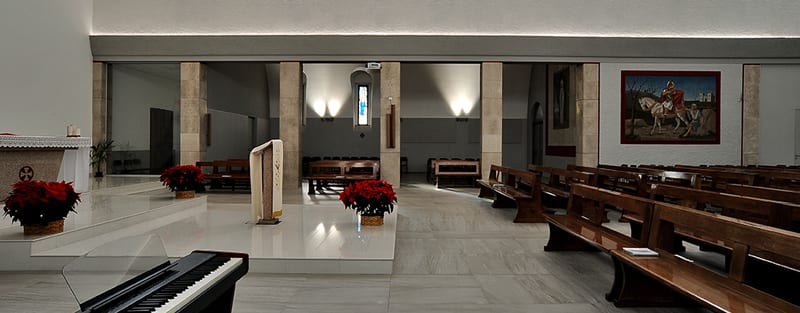Projects


Spiritual matters | by Olivier Namias
Religious architecture is the first form of architecture developed by any emerging civilisation and touches on a fundamental aspect of humanity. As we in the West turn away from religion, we tend to forget this historical reality: the bonds, identity and collective memory of a society are centred around places of worship and it is here that communities continue to be forged today. As the material embodiment of the transcendent, religious architecture is not merely functional, it represents a form of pure architecture that strives to make contact with the user through building structures. Light, space, monumentality and spirituality take physical form through a wide variety of materials and shapes. The gold and marble of baroque churches or the stained-glass windows of gothic cathedrals are the first things that come to mind when we think of the grandeur and splendour of religious buildings. Ceramic tiles could also be included in this list and are found in such majestic buildings as the Hagia Sophia cathedral in Istanbul. Islamic architecture has exploited the unique ability of ceramic tiles to cover surfaces with bright, shiny and indestructible patterns. The Portuguese followed in the Arab tradition by covering the surfaces of churches and monasteries with azulejos, painted ceramic tiles combined to create motifs or educational frescoes depicting the great myths of the Catholic religion.
Due to technical progress and an even wider range of application, ceramic tiles are now an extremely modern material suitable for use in places of worship. They are the perfect decorative tool, ideal for creating the most flamboyant or minimalist decorations. Tiles are also a valuable resource. Their ability to reproduce a custom design makes them ideal for covering entire surfaces, while simply rotating the basic patterns and inserting undecorated tiles or tiles with an alternative design at regular intervals helps avoid monotony. Complementary pieces can be used to delimit these surfaces, to highlight transitions and breaks. Thanks to these endless possibilities, designers can choose from a multitude of options and return to the often overlooked concept of composition based on the choice of motifs, dimensions, geometries and layout. Often it is the simplest layouts that create the most powerful decorations, as in the case of two alternating colours arranged in a chequerboard pattern – a solution that can be made even more complex through the use of different sizes – or the combination of multiple geometries. Ceramic tiles enhance the concept of a module, bringing the large-scale proportions of a monumental wall into relation with the smaller-scale proportions of a hand or foot. This in turn creates an allegory for the relationship between human beings and the divine, between a multitude and the individual, represented in space by the modularity of ceramic floor or wall tiles.

Contemporary tile is a chameleonic product that imitates other materials while remaining true to its own nature, in other words without losing its unique qualities of frost resistance, durability, stability and mechanical strength. Ceramic comes in finishes that reproduce marble, wood, natural stone or concrete while having a longer lifetime and less need for maintenance. Replacing a natural material with a ceramic version is often a way of overcoming the material’s limitations, such as vulnerability to water in the case of wood and stone, porosity in concrete, efflorescence on certain types of oxidised steels. Alternatively, it creates an immediate patina effect that may take several years to appear in the case of materials such as copper. In other words, it transcends the time factor and immediately achieves an unchanging state. Isn’t this one of the conditions of eternity fulfilled by ceramic tile interiors, which retain their appearance for hundreds of years, as demonstrated by religious monuments all over the world? The large size surfaces that have recently appeared on the market satisfy contemporary architecture’s taste for a material look and feel. Tiles as large as 3.2 m by 1.6 m create the illusion of cut stones or in-situ poured concrete, although the absence of joints may end up confusing the visitor. Surface treatment is even more important than in the case of small or medium-sized tiles (30×30 cm). Should it be matt or glossy, rough or smooth? Thanks to the wide range of finishes available, it is possible to find solutions based on luminosity, a timeless and intercultural symbol of the divine presence.

But the use of ceramics is not limited to interiors. Byzantine or Lombard churches owe their striking characteristics to the use of brick architecture, whether the brickwork is used as a structural element or simply for decoration. The range of available bricks is expanding constantly, making it easy to obtain different sizes in a wide range of colours, from earth tones through to highly sophisticated glazed products with sharp or broken edges. The mixture of colours, the possibility of using brick in combination with other modular materials such as glass blocks, and the various alternative layouts available open up enormous design potential for architects. But brick is not the only form in which ceramic can be used outdoors. For several years now, it has also become a popular material for use as large-sized elements on ventilated façades. Here too the designer can experiment with different installation methods: flush mounted, fixed onto slanting planes, alternating colours, etc. But is it really necessary to stick to these technologies, however effective they may be? In recent installations, architects have begun experimenting with the concept of discontinuity and the third dimension. Installed at an angle of 45°, in an alternation of solids and voids, ceramic walls open up to allow light to flow in, modulating and diffusing it. Revisiting the age-old concept of perforated brick walls, these structures adopt new installation systems in which ceramic elements are suspended from grids of cables or fixed to threaded rods. So transcending traditional systems to take ceramics beyond their limits may be the ultimate challenge faced by architects working in the privileged field of religious buildings.
September 2020




